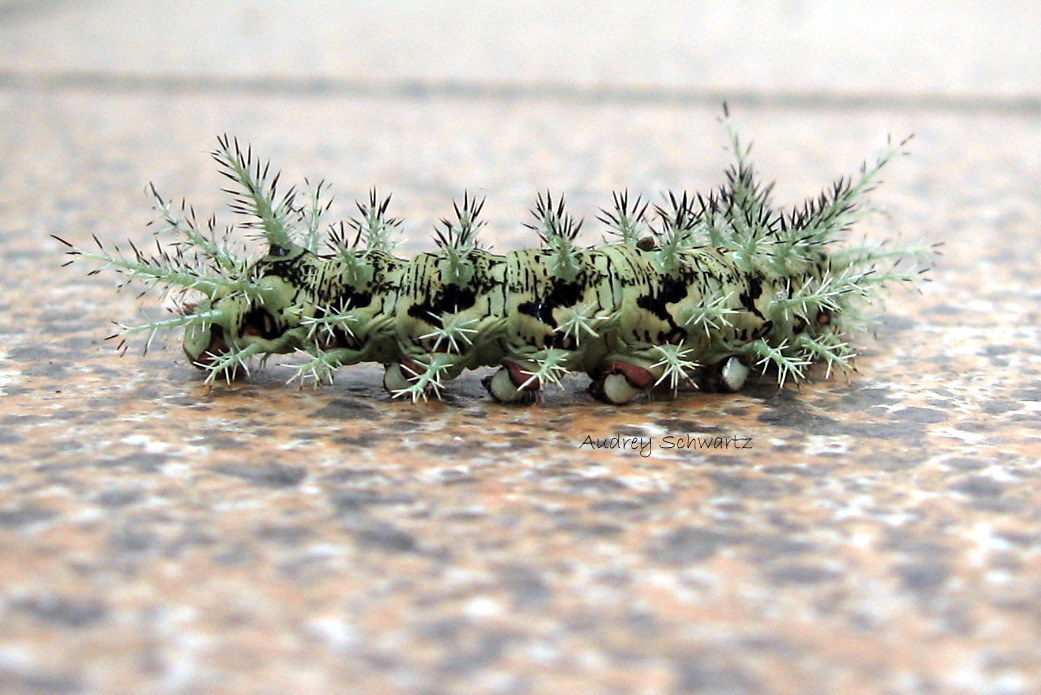Reproduction
Lonomia obliqua has a common life cycle for moths within
its family,
Saturniidae.
A female will lay on average 135 eggs with fertility in about
120 of these eggs (Lorini et al. 2003). A lab study was done in
2003 in Brazil, where they captured caterpillars from the Brazil
rainforests to watch the reproduction of Lonomia obliqua.
In this study, they found an average incubation period of 32
days (Lorini et al. 2003). This data is very similar to that of
others in the same family as L. obliqua.
The caterpillar form of this moth is
the form scientists are very familiar with as it is the part considered to
be very dangerous to humans and is the form most studied. The caterpillars
average 4.5-5.5 cm which is about two inches in length (Lorini et al. 2003). They can grow to
about the size of a male human hand (Lorini et al. 2003) They have a range of body/background
colors from brown to green oftentimes they also have yellow feet and red
spots on their body (Lorini et al. 2007). Their body color allows for them to hide effectively in
with trees and their bark where they the most dangerous to humans (Lorini et
al. 2007). On their
backs, they have spiny crystal-like structures that contain their deadly
venom. These spines are what make the caterpillar so dangerous. If you would
to know more about these spines make sure to check out the
adaptations page
The larval stage of
L. obliqua is the most dominant and easiest to observe. The larvae tend
to stay in groups together oftentimes with their heads pointed outward in
relation to the group, and when disturbed they will start to move in a line and
become active ( Lorini et al. 2007). When the caterpillars reach the later
pupal stages of metamorphosis that is when they start to change. In the pre-pupal stage, the larvae will stop eating, their body size
will decrease while their body becomes a little bent (Lorini et al. 2007) . Their dorsal part will
also become a darker color. In a lab setting, the stage from larva to pupa
take about 60 minutes from the time the larval skin ruptures to when the
outer shell is shed (Lorini et al. 2007). The pupal period is very important
and lasts on average 24-56 days (Lorini et al. 2007). Young pupa will be a
yellowish color and become darker in a few hours. The next day they will
become a reddish brown color and remain this way until the end of the pupal
stage(Lorini et al. 2007) Pupal stages may often occur in the two possible generations in a
year. The first one occurs in October when adults mate and leaves eggs on a
host plant’s leaf, with the other generation occur in March at the end of
summer. The pupae will disappear in the coldest months of the year (Lorini
et al. 2007).
change. In the pre-pupal stage, the larvae will stop eating, their body size
will decrease while their body becomes a little bent (Lorini et al. 2007) . Their dorsal part will
also become a darker color. In a lab setting, the stage from larva to pupa
take about 60 minutes from the time the larval skin ruptures to when the
outer shell is shed (Lorini et al. 2007). The pupal period is very important
and lasts on average 24-56 days (Lorini et al. 2007). Young pupa will be a
yellowish color and become darker in a few hours. The next day they will
become a reddish brown color and remain this way until the end of the pupal
stage(Lorini et al. 2007) Pupal stages may often occur in the two possible generations in a
year. The first one occurs in October when adults mate and leaves eggs on a
host plant’s leaf, with the other generation occur in March at the end of
summer. The pupae will disappear in the coldest months of the year (Lorini
et al. 2007).
Once the caterpillar goes through the changes in metamorphosis they will appear as a moth. This moth is non-venomous unlike the stage before of the caterpillar. They have a very short life and often only live for several days. This is mainly because adults do not feed and their lives are dedicated to mating and laying eggs on continue on generations (Lorini et al. 2007).
Thank you for visiting our site. Next you can look at our references or ways to contact us!